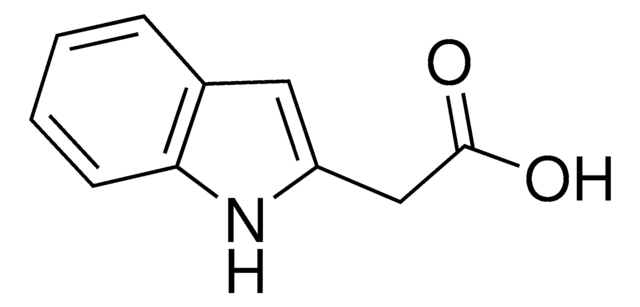I2886
3-Indolessigsäure
suitable for plant cell culture, crystalline
Synonym(e):
Heteroauxin, IAA
About This Item
Empfohlene Produkte
Assay
≥98%
Qualitätsniveau
Form
crystalline
Methode(n)
cell culture | plant: suitable
Farbe
white to pink
mp (Schmelzpunkt)
165-169 °C (lit.)
Anwendung(en)
agriculture
Lagertemp.
−20°C
SMILES String
OC(=O)Cc1c[nH]c2ccccc12
InChI
1S/C10H9NO2/c12-10(13)5-7-6-11-9-4-2-1-3-8(7)9/h1-4,6,11H,5H2,(H,12,13)
InChIKey
SEOVTRFCIGRIMH-UHFFFAOYSA-N
Suchen Sie nach ähnlichen Produkten? Aufrufen Leitfaden zum Produktvergleich
Verwandte Kategorien
Anwendung
- as standard to quantify hormones
- to modify MS (Murashige and Skoog) media for the initiation of callus
- as an external standard in the analyses of free endogenous growth regulators
Angaben zur Herstellung
Lagerklassenschlüssel
11 - Combustible Solids
WGK
WGK 3
Flammpunkt (°F)
Not applicable
Flammpunkt (°C)
Not applicable
Persönliche Schutzausrüstung
Eyeshields, Gloves, type N95 (US)
Analysenzertifikate (COA)
Suchen Sie nach Analysenzertifikate (COA), indem Sie die Lot-/Chargennummer des Produkts eingeben. Lot- und Chargennummern sind auf dem Produktetikett hinter den Wörtern ‘Lot’ oder ‘Batch’ (Lot oder Charge) zu finden.
Besitzen Sie dieses Produkt bereits?
In der Dokumentenbibliothek finden Sie die Dokumentation zu den Produkten, die Sie kürzlich erworben haben.
Kunden haben sich ebenfalls angesehen
Protokolle
Reference guide and preparation guide for antibiotic and antimycotic use in plant tissue culture.
Unser Team von Wissenschaftlern verfügt über Erfahrung in allen Forschungsbereichen einschließlich Life Science, Materialwissenschaften, chemischer Synthese, Chromatographie, Analytik und vielen mehr..
Setzen Sie sich mit dem technischen Dienst in Verbindung.









